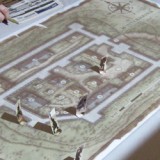The Woman Who Went to Space as a Man – A Memory-Driven Fever Dream
Beginning in 1987 with the suicide of Alice B. Sheldon, the Son of Semele Ensemble takes a fantastical look back through Sheldon’s life with The Woman Who Went to Space as a Man. Through the use of songs, flashbacks and an intricate set piece, The Woman Who Went to Space as a Man is a memory-driven fever dream – one that toys with very real and very poignant issues, even in today’s society.
A Literary Trickster
Born in 1915, Sheldon lived a life bucking the traditions of society. As a woman, Sheldon struggled with her domineering mother and repressed homosexuality (eventually marrying a man), worked as an intelligence officer during WWII, joined the CIA, and earned a PhD in experimental psychology. If that wasn’t impressive enough, at the age of 50, Sheldon decided to write science fiction under a male alter-ego, James Tiptree Jr., who went on to be inducted into the Science Fiction Hall of Fame.
Despite all of her prior achievements, in her writing, Sheldon hid her true identity from the world and filtered her “masculine” voice through the Tiptree persona. During a time in which women were “feminine” and men were “masculine,” Sheldon struggled with gender orientation and the emotional and mental strain it put on her, eventually resulting in her suicide.
A Girl Who Was Plugged In
The Woman Who Went to Space as a Man is an experimental production unlike any I’ve seen. Taking a kaleidoscopic look back through Sheldon’s life, writer/director Maureen Huskey turns the stage into a mosaic of influential moments intertwined with imaginary characters come to life. The Woman Who Went to Space is bookended by a very funny and cleverly staged snippet of one of Sheldon’s short sci-fi stories, a scene and adventure which I would have loved to have seen more of. Throughout the production, Sheldon’s alter-ego, James Tiptree Jr., comes to whimsically dancing life as not just a voice in her head, but as a charming, top hat-wearing gentleman full of panache.
Sheldon’s struggle between reality and imaginary is beautifully made visible through the main set piece: a moving platform randomly covered in bungees. These cords are fastened to the ceiling and sides of the stage, creating a spiderweb of brain connections. Characters (both real and imaginary) skillfully navigate Sheldon’s brain by weaving in between the cords, sometimes even pulling on and releasing them, letting them reverberate through the entire web of Sheldon’s being.
The cast of The Woman Who Went to Space as a Man is top-notch; they expertly bring emotional depth to the whimsical music and narrative. Betsy Moore and Paula Rebelo represent the heart of the show, both playing Alice Sheldon (older and younger, respectively). Moore embodies the tortured spirit of a life lived fighting against her true self, as well as under the spell of the captivating James Tiptree Jr. (brought to life by James Ferrero). Rebelo plays Sheldon during her more optimistic, wide-eyed years of discovery. 12-year-old Alice (Isabella Ramacciotti) suffers under the demands of her domineering mother (Anneliese Euler) and sings about flying away. The ensemble and smaller characters all did a fantastic job supporting Sheldon (and her various iterations) through her memories and imagination.
An Emotional Journey into Space
An experimental production, The Woman Who Went to Space as a Man aims to discuss the importance of identity and expression through the life of one woman. While the idea of someone’s alternate persona taking on a life of its own isn’t entirely new (see Fight Club, among others), the realization of the narrative is quite novel, innovative and well-acted. I don’t think making the production a musical was necessary, but the actors are all adept at singing, especially Rebelo and understudy Emma Zakes Green (who had to fill in for a more singing-heavy role at the last minute), and I quite enjoyed Ferraro’s soft-shoe. The nature of Sheldon’s struggles is unfortunately still a current issue, and hers is a story worth telling (and discussing). The Woman Who Went to Space as a Man, despite its somewhat tragic inspiration, brought a smile to my face on multiple occasions and is an intimate musical that deftly plays with time and space, fictional and real.
Check out more from Son of Semele on their website or Facebook page, and buy tickets here for The Woman Who Went to Space as a Man, running weekends through November 18th.


















